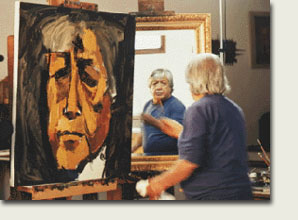Click here to see our available collection
Ecuador 1919 - 1999
Contemporary Art

Oswaldo was born in Quito, the capital of Ecuador, on July 6, 1919. He graduated from the School of Fine Art in Quito as painter and sculptor. He carried out his first exhibit when he was 23.The success in 1941 of his first solo exhibition captured the attention of the collector Nelson Rockefeller who bought many of his paintings and helped him exhibit his work in the U.S. He achieved in his youth all National Awards, and was credited, in 1952, at the age of 33, the Grand Award of the Biennial of Spain and later the Grand Award of the Biennial of Sao Paulo. His last exhibits were personally inaugurated in the Palace Museum of Luxemberg in Paris, and in the Museo Palais de Glace in Buenos Aires, in 1995.
He has executed murals in Ecuador. Venezuela, and Spain. He lived in Quito, Ecuador until his death March 10, 1999, when he was 79 years old.
His work has been shown in museums in all capitals of America and in many countries in Europe, for example, in Leningrade (L'Ermitage), Moscow, Prague, Rome, Madrid, Barcelona, and Warsaw. He carried out 180 individual exhibits, and his production was fruitful in paintings, murals, sculptures and monuments. He has murals in Quito (Government and Legislative Palaces; Central University; Provincial Council); Madrid (Barajas airport); Paris (UNESCO headquarters); Sao Paulo (Latin American Parliament). In his monuments "A la Patria Joven" (To the Young Country) (Guayaquil, Ecuador); "A la Resistencia" (To the Resistence) (Rumiñahui) in Quito.
His humanist work, marked as expressionist, reflects the pain and misery that the larger part of humanity has endured, and denounces the violence that every human being has had to live with in this monstrous 20th. century marked by world wars, civil wars, genocide, concentration camps, dictatorships, and tortures. He had been working on his top work " The Chapel of Man" when he died.
In order to learn the fresco technique from the great muralist José Clemente Orozco, Guayasamín visited Mexico in 1943. His brief stay was key to the development of his later work. Orozco´s work inspired Guayasamín to experiment with a more expressionistic style combined with cubist forms. The works from this period deal with the distortions of the human figure as main subject matter.Guayasamin worked as a cultural attaché for Ecuador in Peru, Chile, Argentina and Bolivia. Few Latin American artists have attained the degree of international renown enjoyed by Oswaldo Guayasamin. His work is a fusion of formal elements derived from Cubism and subjects characteristic of the Indianist trend that was predominant in many Andean countries up to the early 1950's. In his drawings we find the populist, socially oriented philosophy of the Mexican school expressed in updated terms. An expressionistic use of line is responsible for the powerful graphic and literary impact his images of an anguished but rebellious Indian people and there struggles. Guayasamin has always sought to emphasize the disadvantaged situation Of the Indian in Ecuadorian society. This impoverishment, and the cultural alienation he has suffered through separation from his roots. This has been expressed in endless series of paintings and drawings, the most ambitious of which are those entitled "The Age of Wrath" and "The Trail of Tears."
Oswaldo Guayasamin divided his work into three parts: Huacaynam (the road of tears, in Quechua), the age of wrath, the age of tenderness. At UNESCO's request, he had finished a project of a medal to recompense the creative work of major artists. ...
(PLease Login to see the complete biography.)